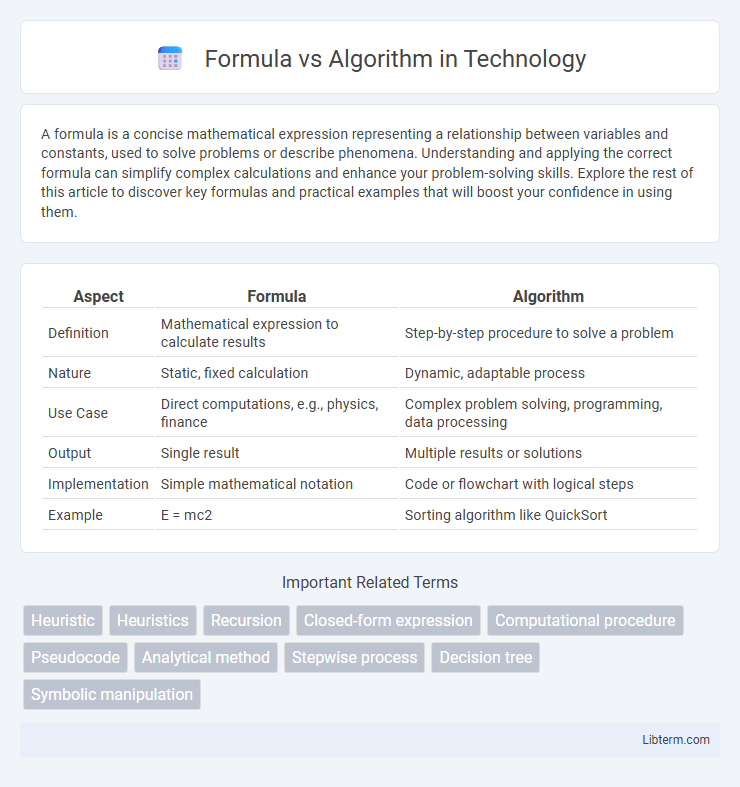A formula is a concise mathematical expression representing a relationship between variables and constants, used to solve problems or describe phenomena. Understanding and applying the correct formula can simplify complex calculations and enhance your problem-solving skills. Explore the rest of this article to discover key formulas and practical examples that will boost your confidence in using them.
Table of Comparison
| Aspect | Formula | Algorithm |
|---|---|---|
| Definition | Mathematical expression to calculate results | Step-by-step procedure to solve a problem |
| Nature | Static, fixed calculation | Dynamic, adaptable process |
| Use Case | Direct computations, e.g., physics, finance | Complex problem solving, programming, data processing |
| Output | Single result | Multiple results or solutions |
| Implementation | Simple mathematical notation | Code or flowchart with logical steps |
| Example | E = mc2 | Sorting algorithm like QuickSort |
Understanding the Basics: What is a Formula?
A formula is a concise mathematical expression that represents a relationship between variables and constants, often used to calculate specific values. It serves as a precise rule or equation designed to solve particular problems or quantify phenomena. Understanding a formula involves recognizing its components, such as variables, coefficients, and operators, to accurately apply it in practical contexts.
Defining an Algorithm: Key Concepts
An algorithm is a finite set of well-defined instructions designed to solve a specific problem or perform a computation. It involves a clear sequence of steps that transform inputs into desired outputs, ensuring accuracy and efficiency in problem-solving. Unlike a formula, which provides a direct mathematical expression, an algorithm focuses on the procedural logic applied systematically to achieve results.
Main Differences Between Formulas and Algorithms
Formulas are mathematical expressions that provide a direct way to calculate a specific value based on given variables, while algorithms are step-by-step procedures or sets of rules designed to solve a problem or perform a task. Formulas typically involve a fixed equation with defined inputs, whereas algorithms encompass a broader, logical sequence that may include decision-making and iteration. In essence, formulas are concise computational tools, and algorithms are comprehensive problem-solving methods used in computer science and mathematics.
Practical Examples of Formulas in Daily Life
Formulas such as the area of a rectangle (length x width) streamline daily tasks like measuring floor space for carpet installation. In finance, the compound interest formula A = P(1 + r/n)^(nt) helps calculate savings growth over time, making it crucial for budgeting. Cooking recipes often use formulas to scale ingredients proportionally, ensuring consistent taste across different portion sizes.
Real-World Applications of Algorithms
Algorithms power real-world applications such as search engines, data encryption, and machine learning models by providing step-by-step computational procedures to solve complex problems efficiently. Unlike formulas, which provide fixed mathematical relationships, algorithms adapt dynamically to diverse inputs, enabling tasks like sorting large datasets or optimizing logistics operations in real-time. This adaptability makes algorithms crucial in industries including finance, healthcare, and e-commerce, where data-driven decision-making drives innovation and productivity.
The Role of Formulas in Mathematics and Science
Formulas serve as concise mathematical expressions that define relationships between variables, enabling precise calculation and prediction in various scientific disciplines. They provide a straightforward method to convert theoretical principles into practical applications by quantifying specific properties or phenomena. In contrast to broader algorithms, formulas focus on fixed relationships, facilitating accurate measurement and consistency in fields such as physics, chemistry, and engineering.
How Algorithms Drive Technology and Innovation
Algorithms underpin technological advancements by processing complex data sets to deliver precise outcomes in areas such as artificial intelligence, machine learning, and software development. Unlike static formulas, algorithms adapt dynamically, enabling systems like recommendation engines, autonomous vehicles, and cybersecurity defenses to evolve and improve in real-time. This adaptability and efficiency make algorithms fundamental to driving innovation across modern digital and industrial landscapes.
When to Use a Formula vs. an Algorithm
Formulas are best used for straightforward calculations with fixed variables, such as determining the area of a rectangle or solving quadratic equations, where direct mathematical expressions can quickly yield results. Algorithms are ideal for complex problem-solving that requires a sequence of steps or decision-making processes, such as sorting data, searching databases, or optimizing routes in logistics. Selecting a formula applies when the problem has a clear mathematical relationship, while choosing an algorithm suits dynamic or iterative tasks that need flexible logic and computational procedures.
Benefits and Limitations of Formulas and Algorithms
Formulas provide precise, fixed mathematical relationships ideal for straightforward calculations and quick problem-solving but lack flexibility when adapting to complex or dynamic data sets. Algorithms offer step-by-step procedures suitable for handling multifaceted tasks and large-scale data processing, yet they can be computationally intensive and require more time to develop and understand. Both formulas and algorithms serve critical roles in data analysis and software development, with their effectiveness depending on the problem's complexity and computational requirements.
Future Trends: Evolving Roles of Formulas and Algorithms
Formulas will increasingly integrate with adaptive algorithms to enhance precision in data-driven decision-making across industries such as finance and healthcare. Advances in artificial intelligence will enable algorithms to self-optimize formulas for real-time problem-solving and predictive analytics. The convergence of formulas and algorithms will drive innovations in automation, personalized technology, and complex system modeling.
Formula Infographic

 libterm.com
libterm.com